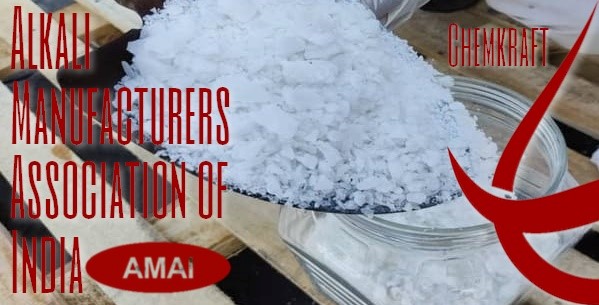AMAI: DOMESTIC DEMAND FOR CAUSTIC SODA UP BY 4.2% TO 41.38 LAKH MT IN 2022-23
AMAI report on domestic demand for caustic soda: Industry body Alkali Manufacturers Association of India (AMAI) recently released its Annual Industry Review 2022–23. The Review highlights the performance, policy initiatives,
customs, GST, anti-dumping and safeguard duties, latest trends on the Indian alkali and chloro-vinyl industries. It also gives a picture of the future roadmap for the industry.
According to the AMAI’s Annual Industry Review, the exports of caustic soda exceeded the imports for the third consecutive year. However, imports of soda ash increased by 2.5 per cent to 5.77 lakh MT in 2022–23 over 2021–22. Imports of sodium bicarbonate increased 27.8 per cent YoY to 19.54 KMT. Even imports of polyvinyl chloride saw a massive surge of 51.4 per cent in 2022–23 to 22.66 lakh MT constituting 59% of domestic demand.
ICN reproduces here snapshot of caustic soda, soda ash, sodium bicarbonate and polyvinyl chloride from the Annual Industry Review 2022–23.
Caustic Soda
Installed capacity touched 55.65 Lakh MTPA which represents about 5.5% of the global capacity and chlor-alkali market is expected to expand with growth in economy. Production increased to 44.73 lakh MT, an increase of 8.3% over the previous year. Capacity utilisation reduced to 80%, largely due to higher capacities that were added during the year.
Domestic demand during the year was 41.38 Lakh MT, an increase of 4.2% over last year.
Imports declined to 1.35 lakh MT (Y-o-Y decline of 33%). The average Import CIF Price during the year is 671 USD/MT for Caustic Soda Lye & 694 USD/MT for Caustic Soda Flakes. For the third successive year, exports exceeded imports.
Exports increased to 4.58 lakh MT (Y-o-Y increase of 34%). The average Export FOB Price during the year is 625 USD/MT for Caustic Soda Lye & 695 USD/MT for Caustic Soda Flakes.
Major consuming sectors for caustic soda are Textiles (17.52%), Alumina (14.69%), Inorganics (12.99%), and Pulp & Paper (5.75%). Chlorine
Domestic demand during 2022–23 was 39.63 Lakh MTPA against 36.59 Lakh MTPA in 2021–22, an increase of 8.3%. Major consuming sectors for chlorine are HCl (17.27%), Chloro-methanes (15.08%), CPW (14.28%), Organics (13.73%), and Inorganics (10.92%).



AMAI report on domestic demand for caustic soda
Hydrogen
Majorly hydrogen consumed as fuel (33.06%) and in HCl (30.12%). Production for hydrogen during 2022–23 was 12,524 Lakh Nm3, compared to 11,564 Lakh Nm3 in 2021–22, an increase of 8.3%.
Soda Ash
Installed capacity reached 43.96 Lakh MTPA which represents about 6.2% of the global capacity. Production increased to 37.18 lakh MT, an increase of 4.7% over the previous year. Capacity utilisation increased to 85%, during the year.
Domestic demand during the year was 39.77 Lakh MT, an increase of 0.7% over last year.
Imports increased to 5.77 lakh MT (Y-o-Y increase of 2.5%). The average Import CIF Price during the year is 410 USD/MT for Soda Ash Dense & 442 USD/MT for Soda Ash Light.
Exports declined to 2.04 lakh MT (Y-o-Y decline of 18.6%). The average Export FOB Price during the year is 432 USD/MT for Soda Ash Dense & 392 USD/MT for Soda Ash Light.
Major consuming sectors for soda ash are Soaps & Detergents (38%), Glass (35%), Chemicals (15%), and Silicates (8%)
Sodium Bicarbonate (SBC)
Capacity remained stagnant at 308 KMT. Domestic demand during the year was 272.5 KMT, an increase of 2.1% over last year. Imports increased to 19.54 KMT (Y-o-Y increase of 27.8%). The average Import CIF Price during the year is 445 USD/MT. Exports declined to 16.54 KMT (Y-o-Y decline of 13.8%). The average Export FOB Price during the year is 539 USD/MT.
Major consuming sectors for sodium bicarbonate are Food/Baking (36%), Industrial incl. FGT (19%), Animal Feeds (17%), and Health Care (9%).
Polyvinyl Chloride (PVC)
Installed capacity marginally increased to 15.95 Lakh MTPA which represents about 2.7% of the global capacity. Production increased to 15.66 lakh MT, an increase of 5% over the previous year. Capacity utilisation increased to 98%.
Domestic demand was 38.32 Lakh MT, an increase of 28.4% over last year.
Imports increased to 22.66 lakh MT (Y-o-Y increase of 51.4%). Imports now constitute 59% of domestic demand.
Major consuming sectors for PVC are Pipes & Fittings (80%), Films & Sheets (8%), and Wires & Cables (7%).
Hossein Moshiri
WA +989124311007
info@chemkraft.ir
Source: https://chemkraft.ir/en/amai-report-on-caustic-soda/
Originally published at https://chemkraft.ir on January 5, 2024.

Comments
Post a Comment